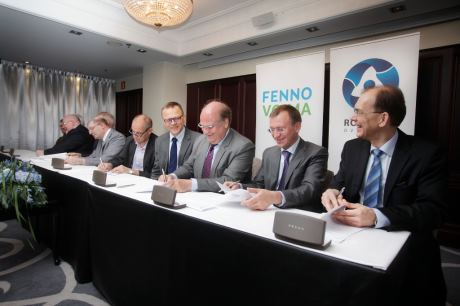Fennovoima, Rusatom Overseas and Finnish labour organisations have signed a site agreement on human resources deployment at the proposed Hanhikivi construction project.
 |
| Fennovoima CEO Juha Nurmi and Rusatom Overseas CFO Vyacheslav Ivanov join leaders of labour organisations in signing the agreement (Image: Fennovoima) |
Fennovoima has committed itself to carrying out the project to build a 1200 MWe nuclear power plant in a socially responsible way, with employment conditions complying with Finnish labour laws and preventing the development of a so-called grey economy. The new site labour agreement sets out cooperation policies and operating principles to achieve that well in advance of any construction work at the site.
The agreement is the result of negotiations carried out since 2012 by a Fennovoima-led working group including bodies representing Finnish construction, technology and energy industries, and Finnish trade unions. It sets out the principles of cooperation to be followed at the site, defining procedures for information exchange, dispute resolution, on-site representation by trade union representatives and practical ways to prevent a grey, or shadow, economy of undeclared work.
Thousands of international workers are expected to be employed on the Hanhikvi construction site. The agreement will help to ensure that the project proceeds as proficiently as possible, according to Fennovoima CEO Juha Nurmi.
Contractor liability issues and the prevention of the grey economy were also included in the plant supply contract signed by Fennovoima and Rusatom Overseas last December. An on-site data system will be used to manage information on sub-contractors and their employees.
Fennovoima's shareholders, including 34%-owner Rosatom, made their final investment decision to go ahead with the construction of a Rosatom AES-2006 VVER unit at Hanhikivi earlier this year. Fennovoima has applied to the Finnish government to amend a 2010 decision-in-principle allowing the construction of a plant based on larger Areva and Toshiba reactor designs to include the AES-2006.
Researched and written
by World Nuclear News




_18570.jpg)
_16159.jpg)
_18938.jpg)
_33584.jpg)





